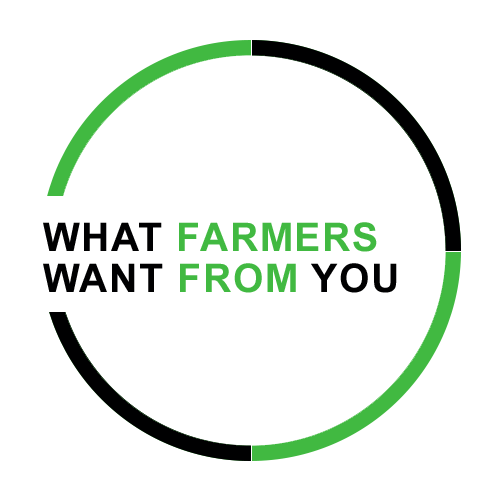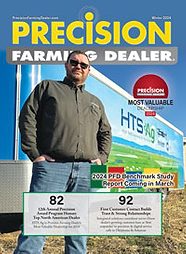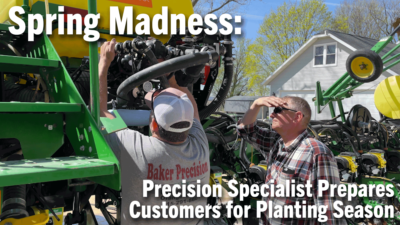 Bill Rohloff operates Awesome Acres, a 1,100-acre corn, soybean, wheat and cover crop rotation farm near Fort Atkinson, Wis., with his wife, Rhonda, and son, Ty. They are entering the third year of a 3 year plan to fully implement precision farming data and equipment in their operation.
Bill Rohloff operates Awesome Acres, a 1,100-acre corn, soybean, wheat and cover crop rotation farm near Fort Atkinson, Wis., with his wife, Rhonda, and son, Ty. They are entering the third year of a 3 year plan to fully implement precision farming data and equipment in their operation.
“Once we have that, we will build our yield maps to identify low, mediocre and high yielding areas in our fields,” Rohloff says. They could have started yield mapping with 2 years of data, but the first year was an extremely early, dry year and last year was extremely wet and cold.
Rohloff decided to go with an RTK signal from the beginning to achieve sub-inch accuracy. He uses an Ag Leader GeoSteer receiver and auto-steer system for equipment guidance and an Integra monitor to capture field data. They installed the components themselves.
“Installing the auto-steer system and monitor wasn’t too difficult on our John Deere 8225 tractor, which came factory-ready with the auto-steer valve,” Rohloff says. “I had the dealer technician here at the beginning, which was a big help. With his initial guidance, installation went well.”
In 2013, the Rohloffs added row clutches to their 24-row Kinze 3560 planter. Installing the row clutches and the harness was easy, Rohloff says. The auto-shutoff for rows saved quite a bit of overseeding on point rows last year and they look forward to implementing variable-rate seeding and fertility levels once they get their yield maps established, he says.
Rohloff has also found the auto-steering system makes long planting days less fatiguing. “In 2013, because it was so cold and wet, we sometimes planted until midnight or 1 a.m. The auto-steer system made working those long hours easier,” he says.
In 2014, the Rohloffs are adding a wireless CDS-John Blue liquid fertilizer monitoring system to the planter. It uses Redball flow monitors and electronics to transmit data to an iPad tablet computer in the cab.
“It will help us catch fertilizer malfunctions right away and since it is wireless, there is less clutter in the cab,” he says.
Points of Pain: Cost-Efficient Compatibility
Rohloff has minimized his points of pain by becoming a student of the precision systems. He is a big fan of the equipment manual, webinars and any dealer training when it comes to understanding precision technology.
What Farmers Want From You is a series of farmer profiles that examine the scope of precision farming tools individual farmers are using on their operation, along with the frustrations that can occur with adopting new technology and how dealers can alleviate those "points of pain" for farm customers. For the latest additions to the series, visit our What Farmers Want From You feed.
“I read the manual and use it while I am installing and setting up the equipment. I also attend meetings the dealer has and take advantage of webinars to learn more about this system. This helped me head off problems,” he says.
Even with this studious approach, Rohloff would like to see more compatibility across systems.
“We had to use a Paradyme auto-steer system with our Claas 740 combine to capture yield data last year. The combine came with the Claas Electronic On-Board Information System (CEBIS) and its telematic auto-steer system that can gather yield data,” he says. But the CEBIS and Integra units were not completely compatible.
“We were able to connect our monitor to the CEBIS system, but we had to use a different unit for RTK reception so the monitor unit could record yield data,” Rohloff says. “That unit cost us $11,000.”
In 2014, they will be able to use their GeoSteer system instead, but Rohloff admits he’d like to see lower cost and less complicated compatibility options available.
“I don’t like the thought of paying thousands of dollars to be able to share the monitor between pieces of equipment,” he says. “If it would work across more pieces of equipment without expensive brackets, it would lower our cost.”







Post a comment
Report Abusive Comment